For the exhibition this year, as part of the “Practice” module we were to work through a project with no real constraints other than it should be ready for an exhibition in April 2024.
Liminality
Back in October for the practice module we were given the brief and told to get on with planning shoots, conducting shoots, developing ideas and eventually preparing for a show in April. In November we had a Practice Tutorial with Sylvia and I discussed that I had been taking images of empty buildings and structures and had been looking into Liminal Spaces.
A week later we had another review with the whole group and I shared my Liminal Space plans for the year. I’d been investigating some of the images that I take and how they fit in with the phenomenon that is widely known about on the internet whereby images have an “uncanny valley” feeling to them and look to be unsettling.
I had been researching the likes of Todd Hido’s work, Liam Wong, Edward Hopper, Syd Mead, Masataka Nakano and Backrooms type images on the web. I found that I could go out and make images that fit in with the transitional phase of a journey, in the middle of two points.
As December rolled around we had another review with the group and Sylvia. I discussed two shoots that I’d made recently, one around the factory where I work and another around the seaside at Margate and Southend. The shoot around my workplace stirred something in me and I’d go on to concentrate on this as the central theme for my Practice for the academic year.
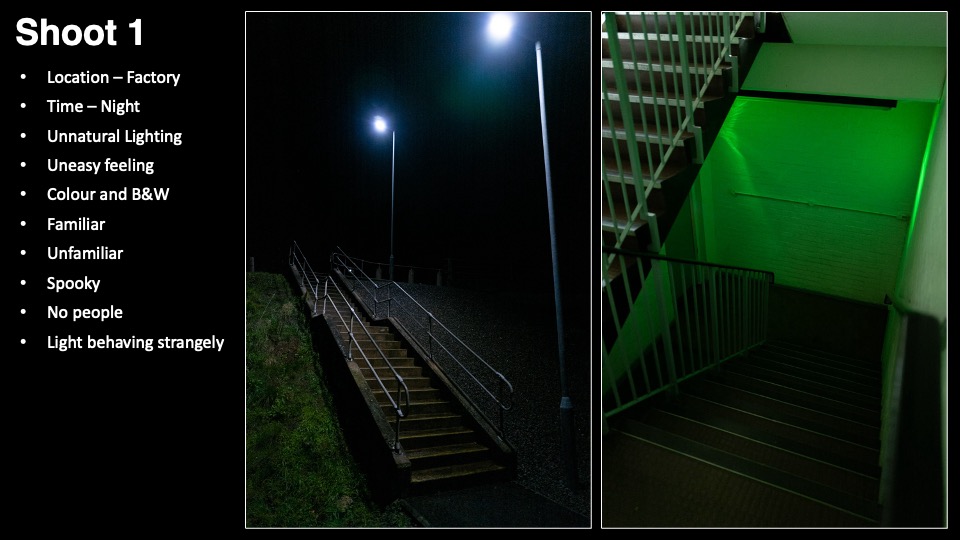
My plan after this was to conduct another shoot in the factory after dark, as well as take some photos on my January adventure to Japan.
The trip to Japan in January was amazing and I took so many photographs, but there were not many that were related to the Liminal Space theme that I was working on at the time. There were a few images and after considering these against the Factory based photos I decided that I wanted to concentrate on the workplace bound images.
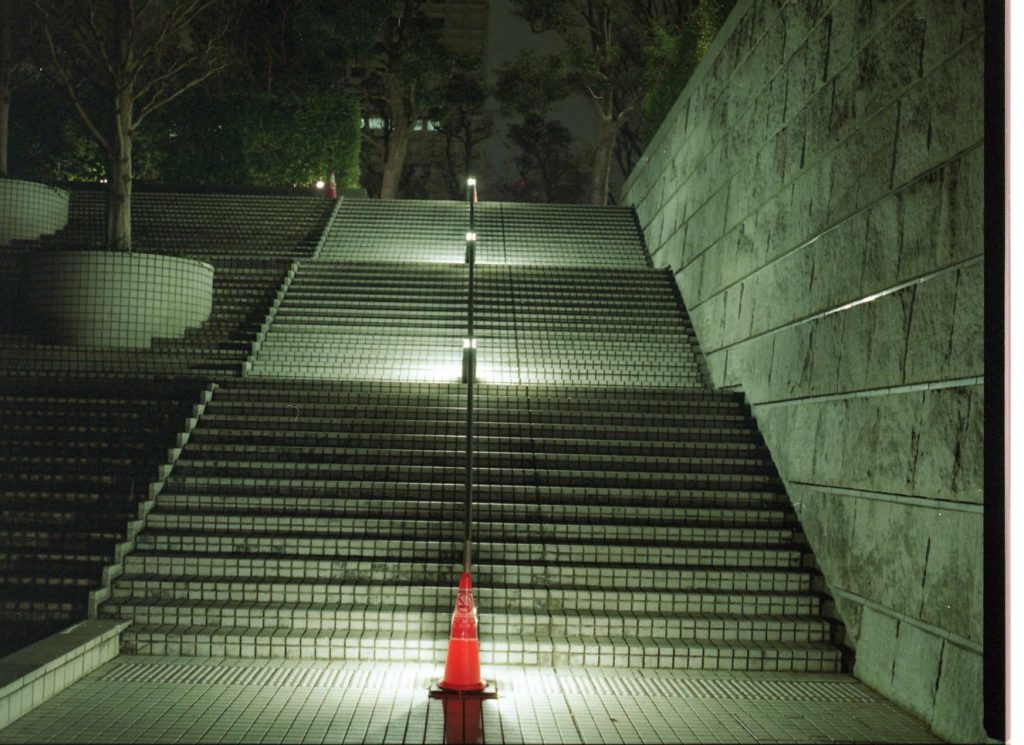
Direction Change
The discussions around changing from strictly Liminal Spaces to something else related to the workplace. In another tutorial we moved forwards with this idea that I am only just now discovering parts of the factory where I have worked for such a long time. This was related to my promotion in August, the role change that I now have and the way in which have responsibility for the buildings.
We discussed that I might be able to canvas people I work with for their opinions on the photographs that I have made. This would happen ultimately by me creating a zine and taking these in to my work colleagues.
Shoot 3 was the factory at night time again. The factory shuts down for the Christmas break and as the manager of the Site Services and Facilities it was my job to wander around with the Facility Manager (MD) checking all was locked and turned off. As I’d finished this activity I wandered with my Leica Q2 to capture some further shots. The word “Shutdown” became the title of my series of images for the end result as a result of this shoot.
In between here we saw a few weeks of disruption due to the cyber attack on the university that would lead us to not be in the building much and I could get on with the other work I needed to produce.
A tutorial in Week 6 was held to discuss some of the images that had come from this final shoot and how they fit in with my narrative of working in the same place for such a long time, with the journey from 16 year old apprentice to a 50 year old manager being at the centre of it. During this tutorial Sylvia asked for some printed images that we might take a look through at the following week, I also discussed that I have an archive of scanned images from the factory and employees who used to work there she was interested in these images also.
In the middle of March we sat down once more to discuss my practice this far, and I shared some prints as well as some digital shots of the archived images. We discussed why these images mean a lot to me and what they represent in terms of places and parts of the story of my life. In the same afternoon we met up as a group to discuss the exhibition strategy and what we would call it, how we would handle the logistics and the promotional material surrounding it. We also had a visit to the exhibition space at Eagle Works so we could see where we might place our artworks for the exhibition. We came up with a plan of where and how we might present our works. I created a document showing the floor plan of the Eagle Works that I’d managed to pull together by taking a laser tape measure with me on the visit.
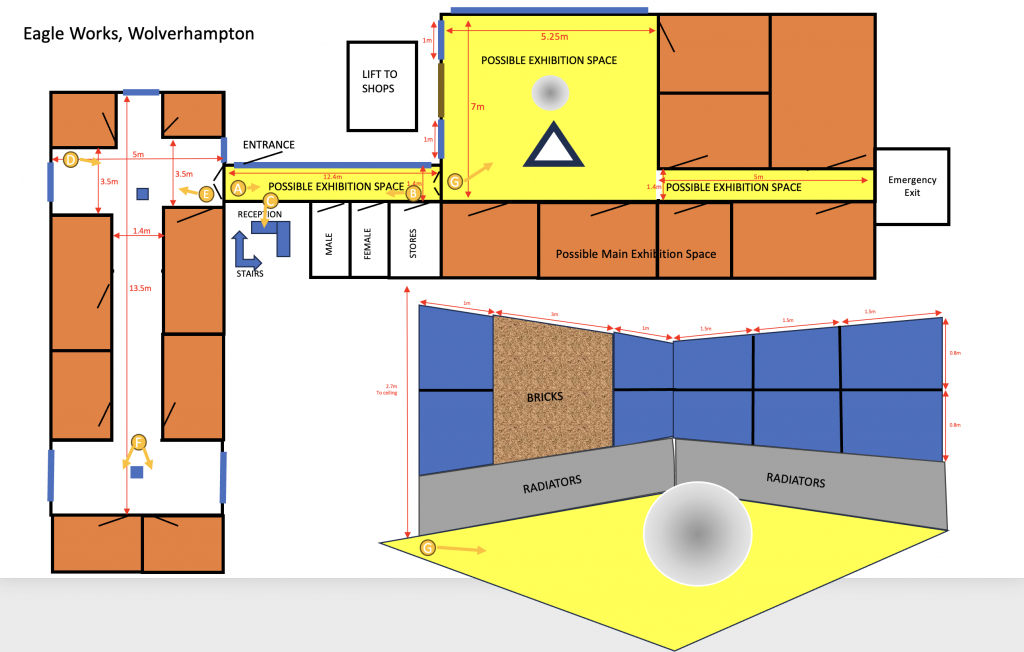
Filling The Space
It was at this time I came up with the idea of presenting three of my images on an industrial style structure, using wooden pallets in a triangular layout.

This morphed into the following idea where three pallets were held off the floor using metal poles. The prints were all but selected finally and I was selecting between metal prints and acrylic. A print on brushed aluminium I’d had done recently left me thinking that the black might not come out properly on it, and as I’d had a photo of the Manhattan skyline at night put on acrylic, I figured that this might be the best method to display. The below image was one I’d put together to allow Sylvia and my coursemates to picture it when they revisited the space later, I was unable to make it at this time due to my involvement in an audit at work. Yep, don’t forget I also have a full time job.
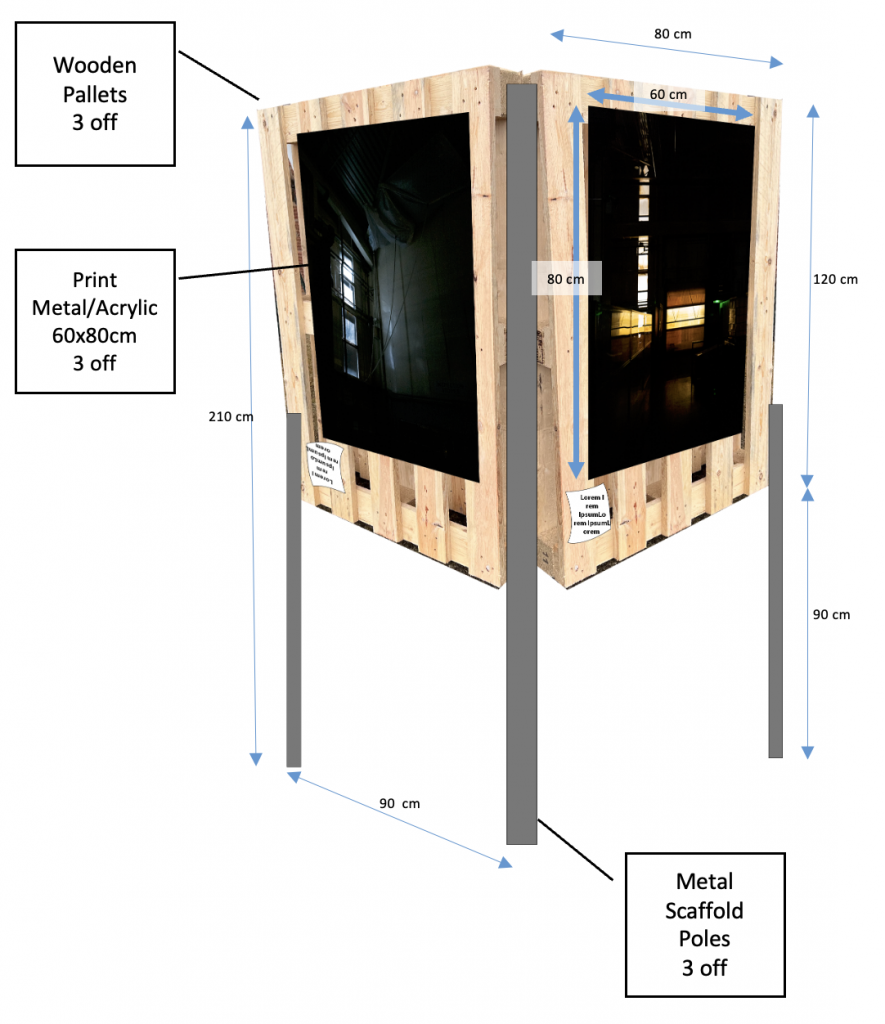
Exhibition Prep
We used this session as a group to each give a brief overview of the work we were presenting so that we could come up with a title, group statement and individual statements that all tied together. This is all documented in this post.
In week 9 we sat down together to smash a few ideas and see what would stick, posters for the exhibition were produced by Shellie and Bethany as below.
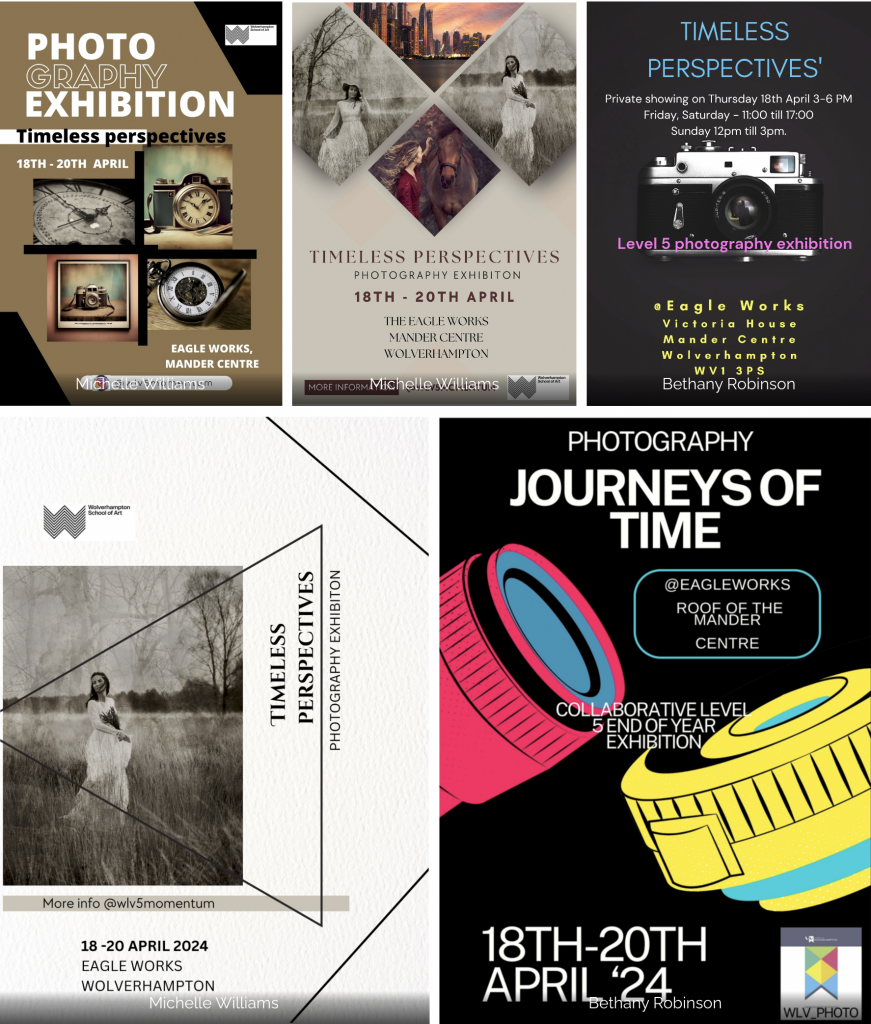
We discussed what we would need to prepare ahead of the exhibition and the tools and processes we’d need to follow, how to promote it, the instagram account, the locations of the works etc.
We did some of this work on Instagram chat but after some personal issues between coursemates we began using the Discussions tool in the Canvas app so that it was viewable by University staff. We have a few different threads in flight, talking about exhibition, about the poster, the exhibition statements, the artists statements and how we go about the promotion of the exhibition.
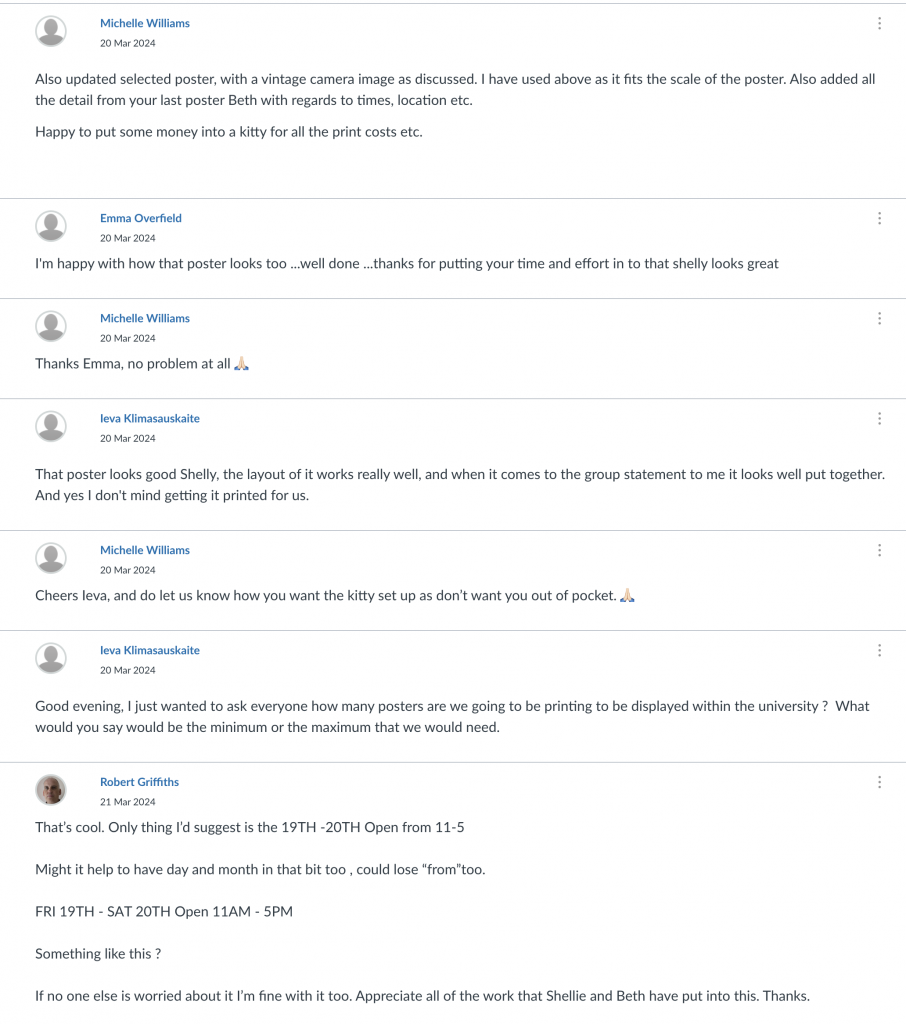

Mounting Problems
At this sort of time I was figuring out how to deal with the fact that the three pallets mounted together was going to be too large. This was a result of the team going to Eagleworks when I was in the audit, and I didn’t mind at all as it gives me something else to think about and write about in my journal. With the further development as detailed in this post it became apparent that I had a method of mounting three images on the one pallet as long as I could fix it to the wall for safety.
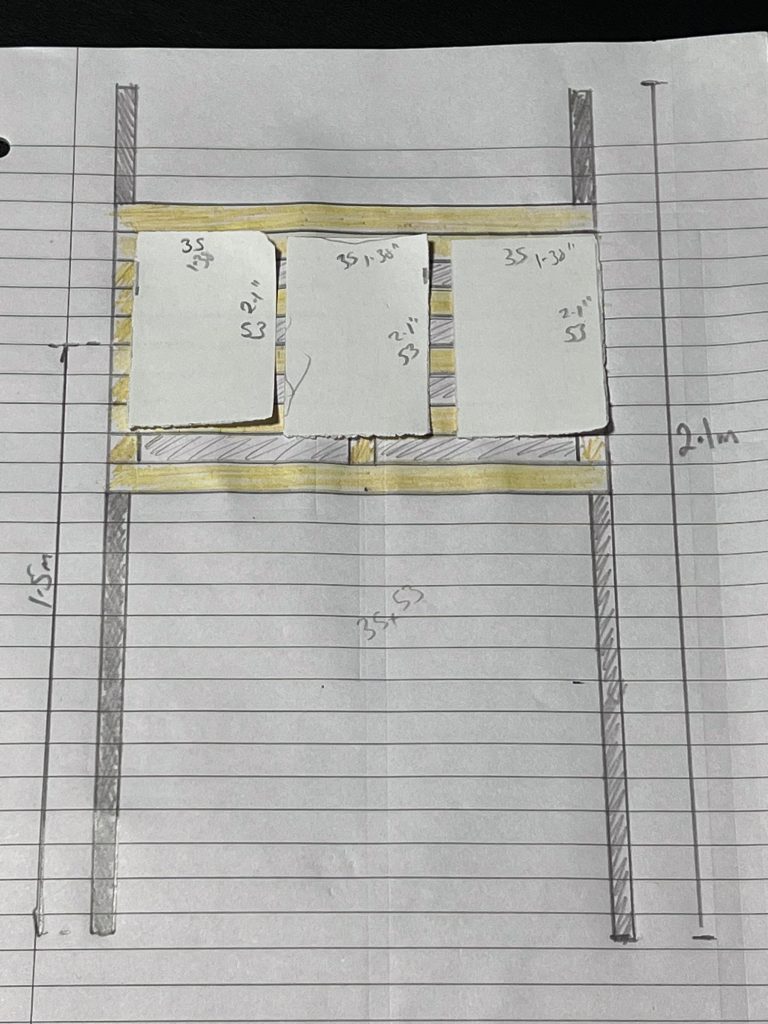
You can see in the Poles, Pallets and Prints post mentioned above that I set about to pick up some parts to get on with the preparation of the installation. This was selected and with the correct clamps and poles in place I could trial fit the newly arrived prints. These came from SAAL Digital and I was incredibly happy with them. They were directly printed onto the acrylic and then covered over with a protective white film on the rear. They had factory fitted, museum quality mountings on the rear and this would ultimately help me mounting them on to the pallet when it was all up and assembled. Until then, they would remain under their protective plastic covers inside their cardboard sleeves.

At this point I thought about some LED lighting on the rear to provide some atmospheric lighting on the wall behind the images. Not to backlight the images though as this would lose the richness of the black dark parts of the images, which is what the photos were about really. I picked up some Ikea 1m long RGB LEDs and tested them at home before fitting them to the rear of the pallet.
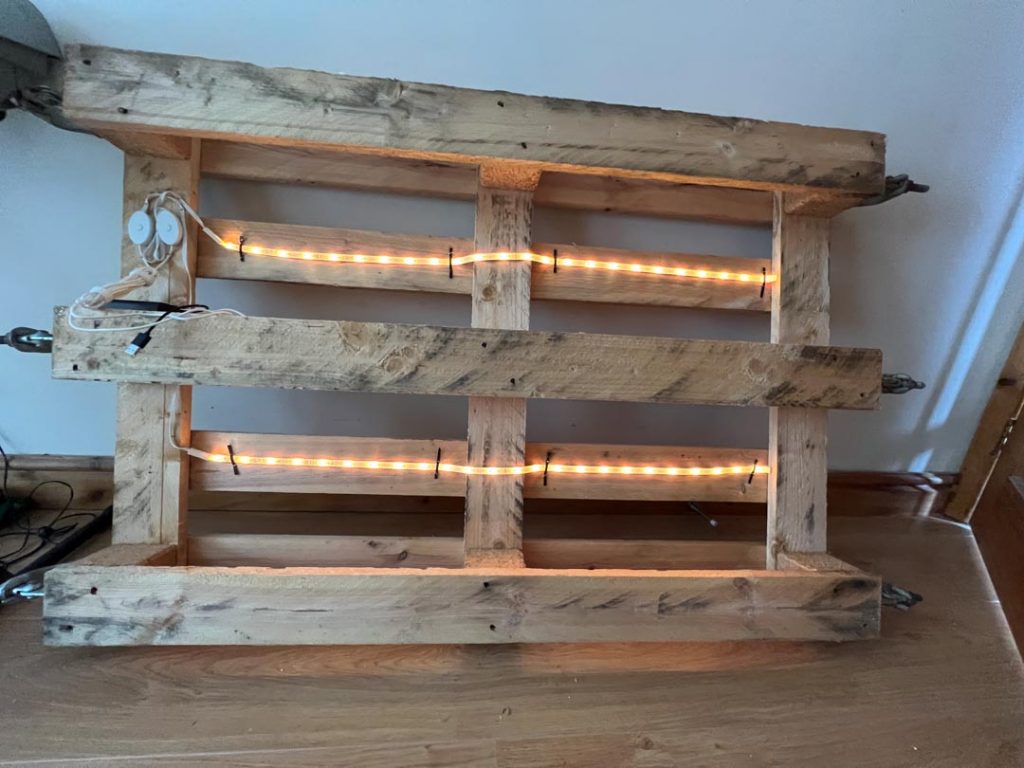
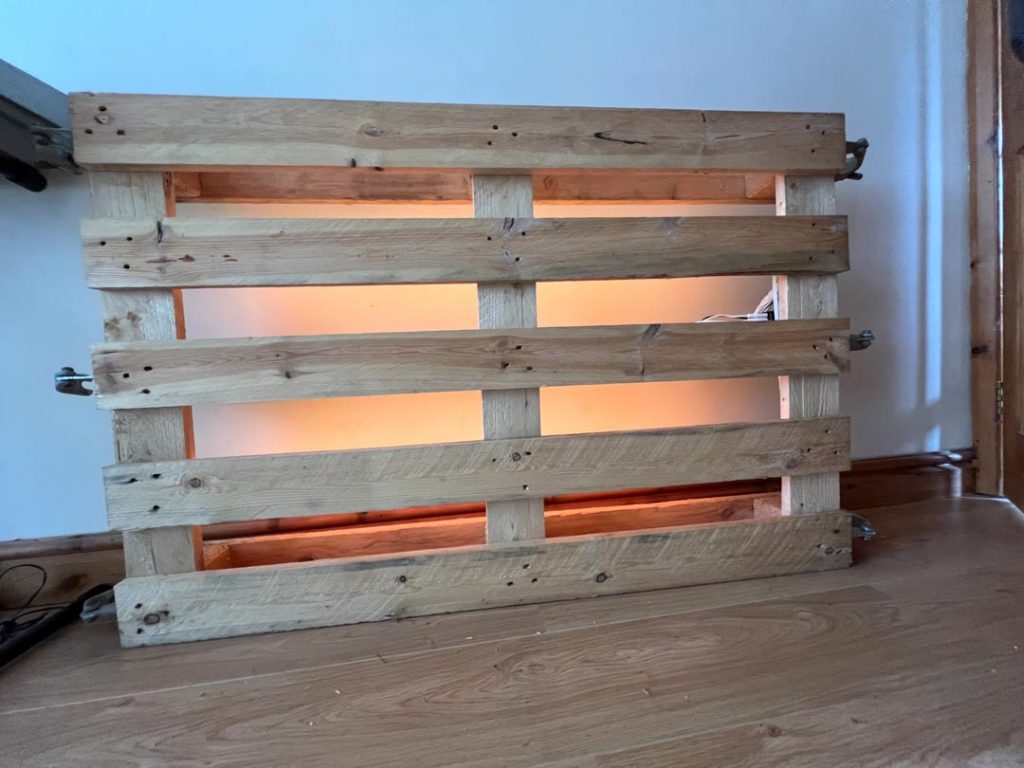
We had a tutorial on the 10th April that would be the last before the install of the exhibition on the 17th. I ran Sylvia through my plans and she seemed ok with everything we had discussed and didn’t seem to have any real concerns. It was discussed that I had needed to adapt my work to fit into the space and experiment with different methods of presenting the work, whether it was on the wall directly, one large print or several smaller prints, but I still wanted a link to the industrial nature of the photographs. The pallet would be ok as shown in the image of the hand drawn image above.
Zine Printing
I also had back in the mail the 100 copies of a zone I printed using Mixam. These were titled Shutdown as per the series of three photos that I’d be exhibiting and contained some of the shortlisted photographs that didn’t make it into the top three (and the top three). There was a text on the last page that explained some of what would appear in my artists statement next to the work in the show. The plan to have these nearby and allow them to be picked up for free was a good idea too according to Sylvia and others that I’d asked.
The zines I took into work and distributed a few around my colleagues, peers and team members to elicit some feedback. Some of the feedback was exactly what I envisaged and also helps me with my contextual work about atmosphere in photographs. Some of the people who had a zine looked at it and told me it reminded them of zombie apocalypse films, derelict places, spooky old buildings and movie sets for run down disaster flicks. Others used words like atmospheric, eerie, spooky, creepy, abandoned, derelict, frightening, fear inducing, lonely, and scary. This aligns with the questions I asked in the survey for the contextual visual analysis work and I found it to be a good crossover point between the Practice and the Contextual works we are working on simultaneously.
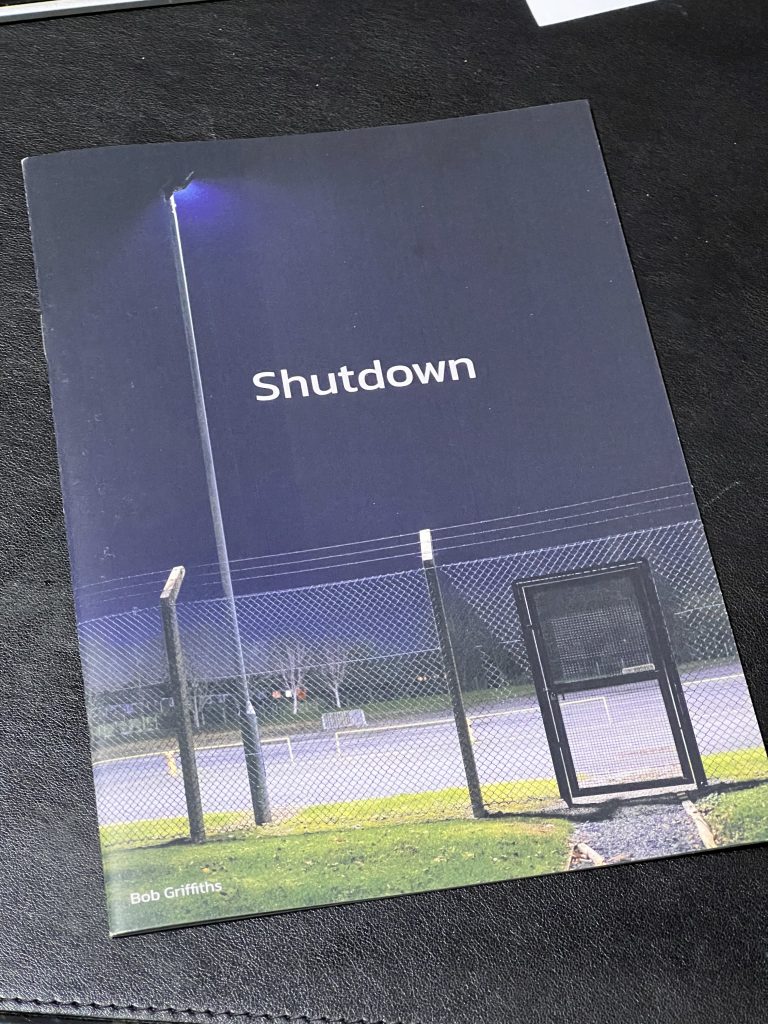
Installation
The installation day rolls around so I’ve loaded the pallet and the poles into the car, as well as all of the tools and rock up at the Eagle Works nice and early to get the cheaper all day parking. More of this day can be found in the post detailing the activities and the reflections of the install. Suffice to say that once I’d got my structure into the building and assembled it, most of the hard work was done. I drilled three holes into the wall to support the pallet but these wouldn’t be visible once the images were hung on the front of the pallet.
The hanging was tricky as I needed to get them level and equally spaced across all three 35x53cm pieces of acrylic. Using my spirit level and tape measure, along with my pre-designed template of measurements it was soon completed and the images hanging with their protective plastic films on for now, in case any unfortunate mishaps were to occur. I consider my work to have been installed and ready, ahead of the rest of my colleagues but that is down to having the materials already at home and available to practice with. Some of the other coursemates had issues getting their prints back from the framers or the print and mounting teams, and others had issues with the props that they were relying on too. I am very aware of how I used to leave everything until the last minute, resulting in a lot of stress, panic and often substandard results. As a result of these life lessons learned in the past I am careful to get items on the lists completed with plenty of leeway for supplier mix-ups etc.
Whilst my work was hanging and almost ready for the show, I was able to help my fellow togs with their installs, teaching a couple how to use the tools, which I have been fortunate enough to learn from people throughout my extensive career. It was a good feeling to help people, but I was careful to assist only and not do everything for everyone. I find that if you take over and do it for the person, they will never learn or feel comfortable trying it out.
With the Tuesday install completed for most, Wednesday was a day for finding the finishing touches and printing the artist statements off on nice paper for the walls next to the works, and shopping for the supplies to enable the private viewing to go off faultlessly. It was tricky trying to get the artist statements together so I could get them formatted and printed off to be consistent across the artists. The other six classmates came up with the good and by 11pm I’d been able to print off the statements safely.
Launch and Private Viewing
Soon the Thursday would roll around time to tidy up, help with installs for a couple of others and then assist getting people from the School Of Art in the MK Building, to the Eagle Works on top of the Mander Centre. The private view kicked off at 3pm and the exhibition closed at 6pm for the evening. The event went off with no disasters or real issues and everyone was very complimentary about the work and the presentation of the work.




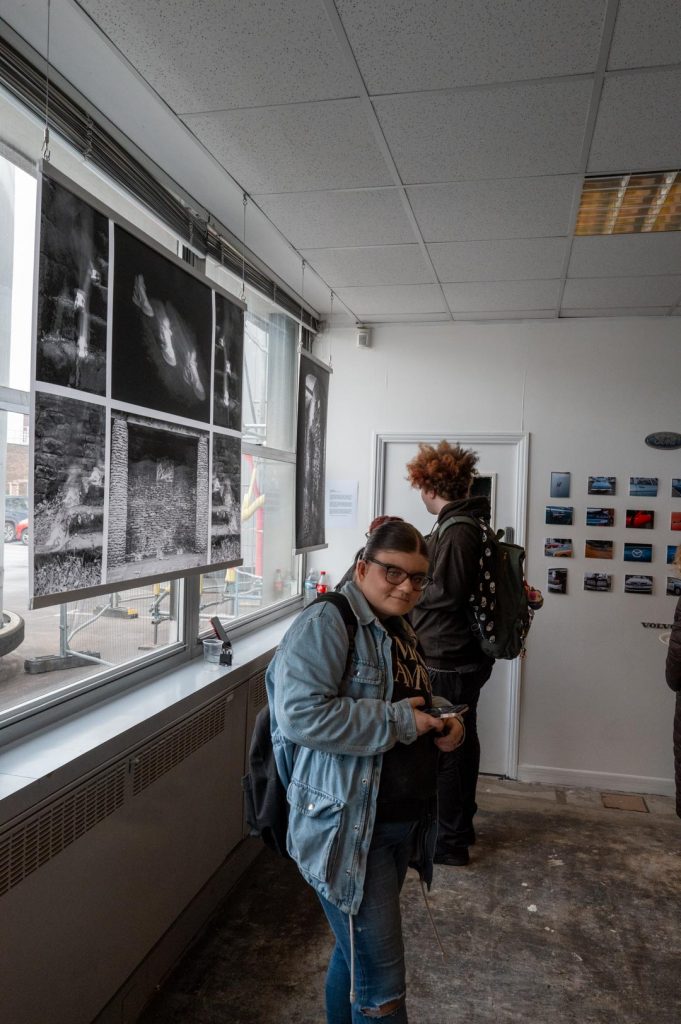
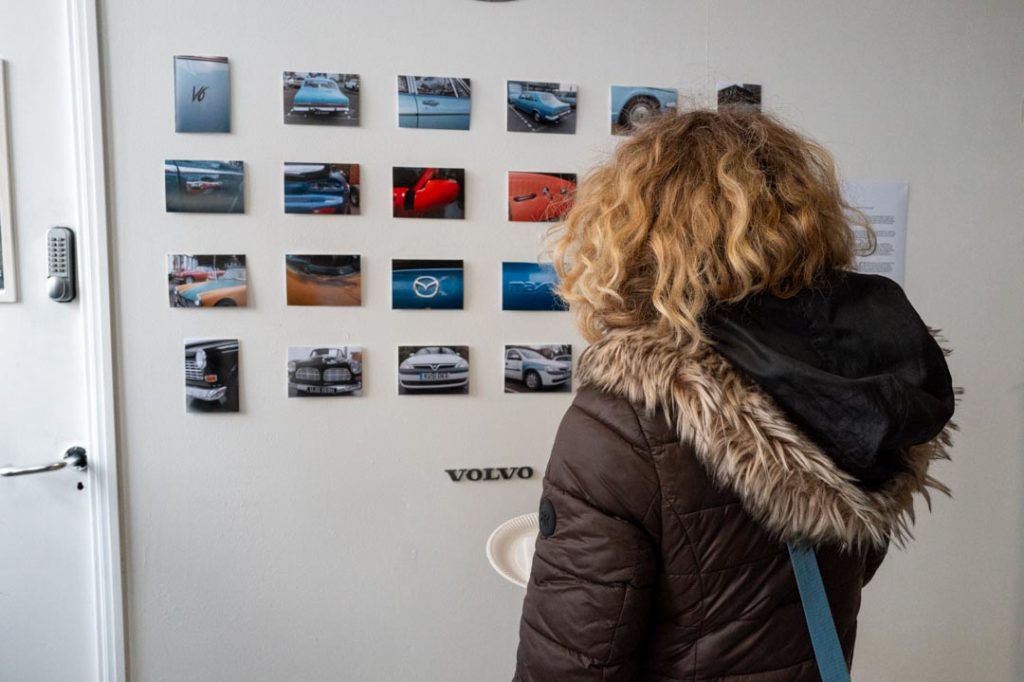

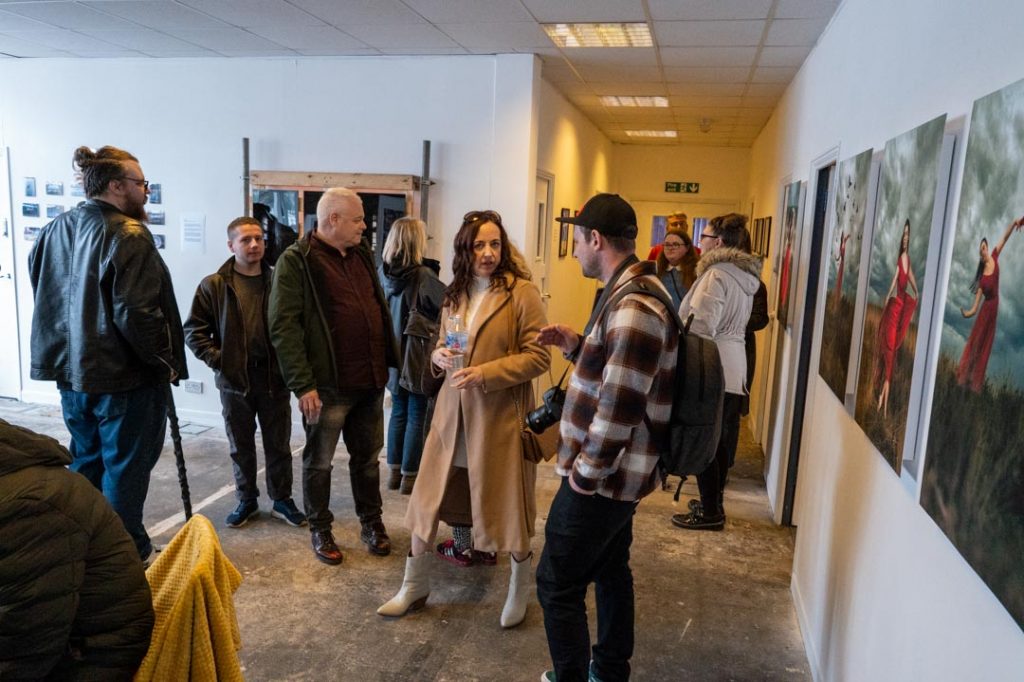

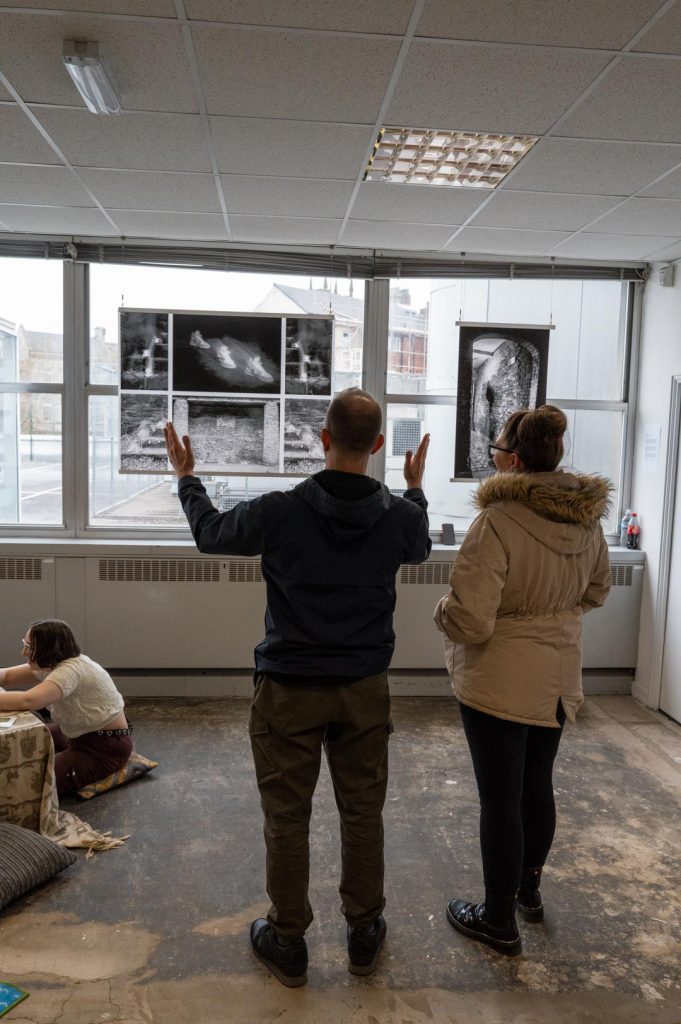
It was great chatting to people who were genuinely interested in the work on display and understood what we were doing. I talked to a few people who asked me some searching questions about the work, about my full time job, and about the reasons why I chose to do a degree in photography. Some of the comments I had from people were around the choice of the material to print onto, whether it was dibond aluminium or acrylic. They were generally complimentary about my presentation with the pallet and scaffold poles and seemed surprised that I could source the materials and put it together myself.
Some of the words that people used were also reflecting my earlier comments from work colleagues and I was pleased that this also allows me some tie in to the contextual works again.
Installation Photos
The module brief details that we must provide professional installation photos of the works and reflect on them too. I’ve been to a few exhibitions, eg. Moriyama at the Photographers Gallery, Saul Leiter at MK Gallery, Vivian Maier at MK Gallery, Maurice Broomfield at the V&A, Beyond the Streets at Saatchi Gallery, Chris Killip at the Photographers Gallery and trips to National Gallery, National Portrait Gallery, in the recent years and have some of the exhibition catalogues and pamphlets as well as many photos I’ve taken at exhibitions and galleries. I knew that I needed to capture different images of my work in different angles, in much the same way that movie directors and photographers do. An establishing shot showing the environment from a distance, a medium shot showing the subject closer and then a final close up of the subject. Bearing this in mind I made sure to cover these requirements off whilst ensuring I capture the best angles of my work.

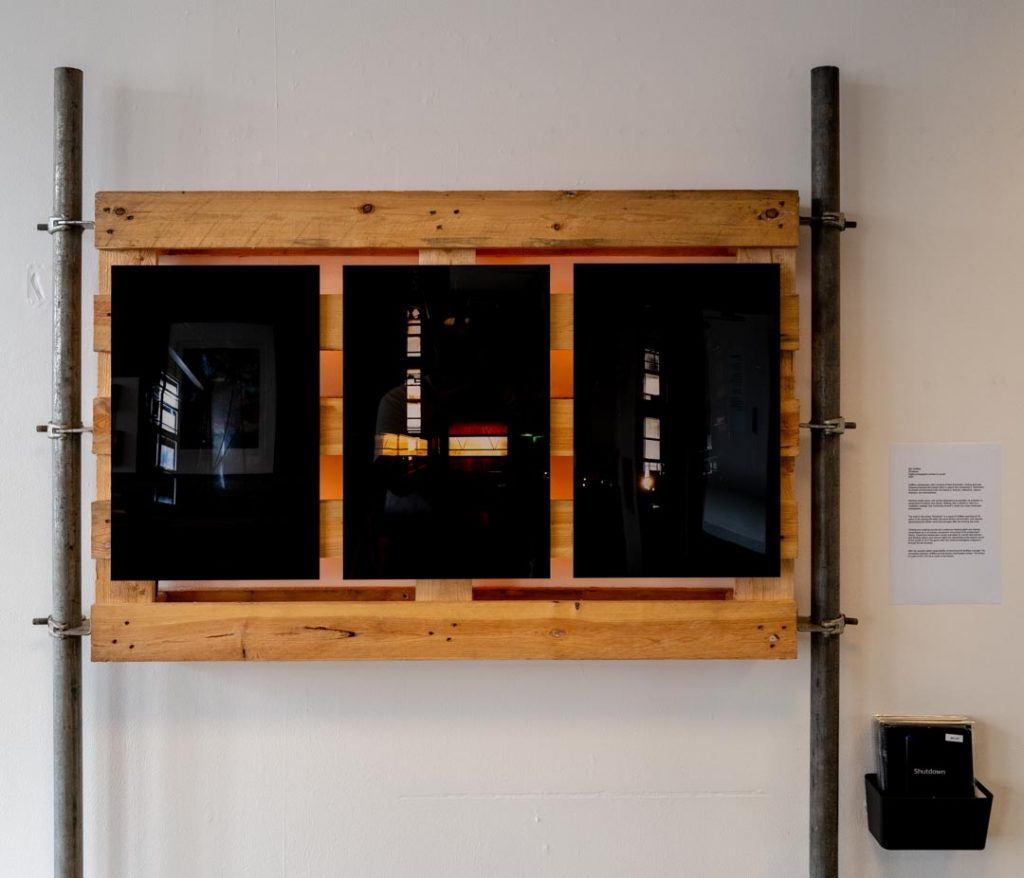
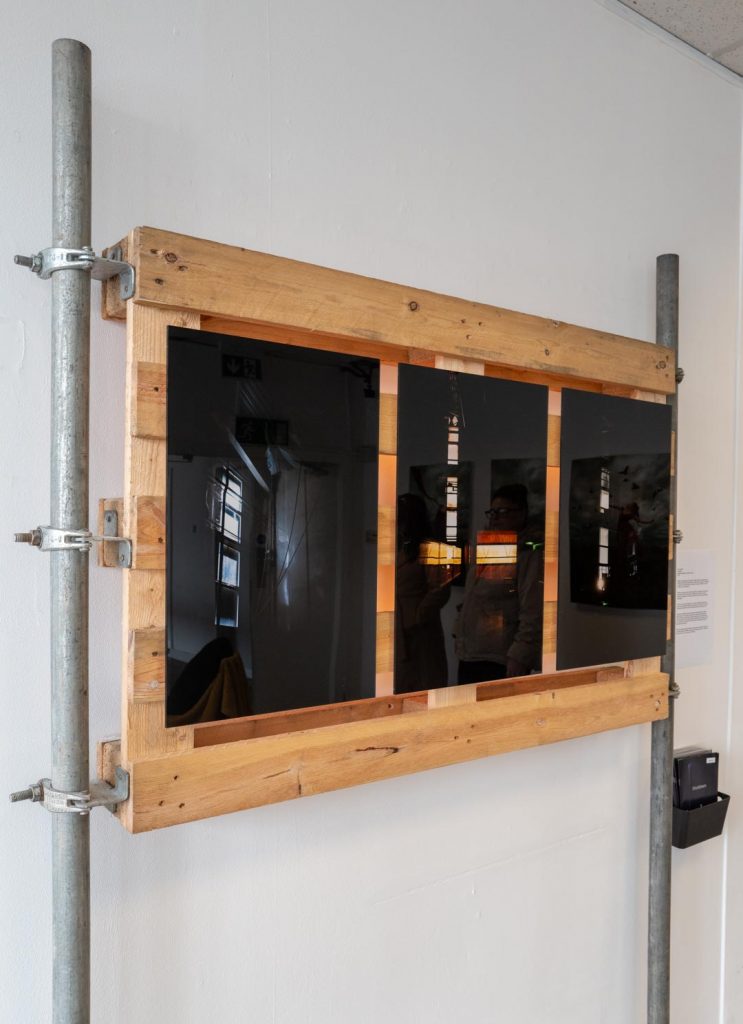

Group Statement
The groups statement to be printed out on an A1 sheet for visitors to read as they enter the exhibition can be seen here. It was talked through in the lecture theatre and also on instagram chat and Canvas discussions to ensure it covered all work of the photographers involved.
In our exhibition ‘Timeless Perspectives’ we, a collective group of photographers, explore the theme of time in various ways.
Through our lenses, we capture fleeting moments, echoes of the past, and the beauty of the present in our own unique and diverse ways. Time, for us, is a force that shapes our memories and our future.
Our images invite you to pause and reflect on the different ways time unveils its essence.
As a group, we celebrate the art of photography as a timeless medium, capable of freezing a single moment or encapsulating history. Join us on this journey through time, where each photograph tells a story of its own.
Level 5 Group
Artist Statement
For our own individual works we had to produce a statement that would be printed on A4 and affixed to the wall near to the work. We did this by collaboration and sharing ideas, as well as a conversation with Sylvia to ask for advice, which was noted and duly acted upon.
Bob Griffiths
Shutdown
Digital photographs printed on acrylic
2024
Griffiths’ photography often employs limited illumination, finding darkness intriguing because few people seem to spend time embracing it. Abstraction of unseen environments fuels his interest in textures, reflections, colours, shadows, and atmospheres.
Working mostly alone, with as few distractions as possible, he embarks on adventures to explore new places. Walking with a camera in hand is a meditation strategy fully immersing himself in street and urban landscape photography.
The work in this series “Shutdown” is a result of Griffiths spending all 35 years of his working life within the same factory environment, only recently appreciating the hidden world that emerges after the working day ends.
Clicking and creaking sounds join mysterious flashing lights and hissing compressed air in an echoey cacophonic recounting of his employment history. Expansive warehouses usually populated by overall-clad workers and blinding sodium and mercury lights are abandoned at the bizarre sound of the buzzer to sit in the gloom with only external streetlights creeping in through the tall windows.
With the recently added responsibility of becoming the facilities manager, the connection between Griffiths and the factory intermeshes further. The factory is a part of him, and he is a part of the factory.
Bob Griffiths Artist Statement
Feedback
As part of our organisation for the exhibition, we’d arranged to get a visitors book where guests could leave a comment or feedback on the show or just say a few words.
As I’ve seen at many other exhibitions in recent years there is usually a digital method of leaving feedback also. Our university Office 365 account comes with access to the Forms application, and I’ve used it for primary research on my contextual essay this year as well as my projects for last year. As I know how to use it and value the tool I thought I would put together a basic feedback form and then produce a QR code which could be scanned in the gallery, taking a user directly to the simple questionnaire.

The responses on the form were few, only three in total.
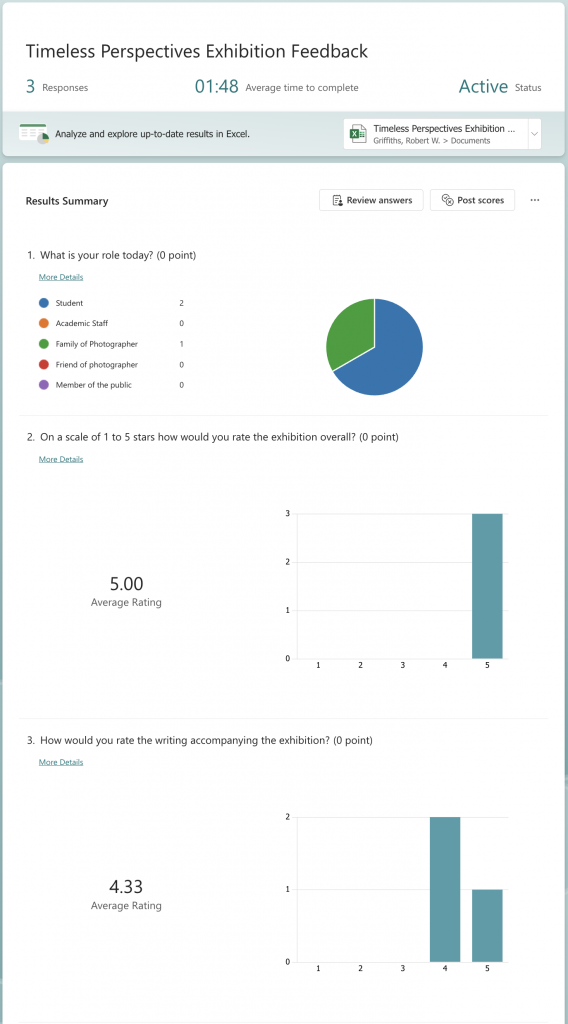
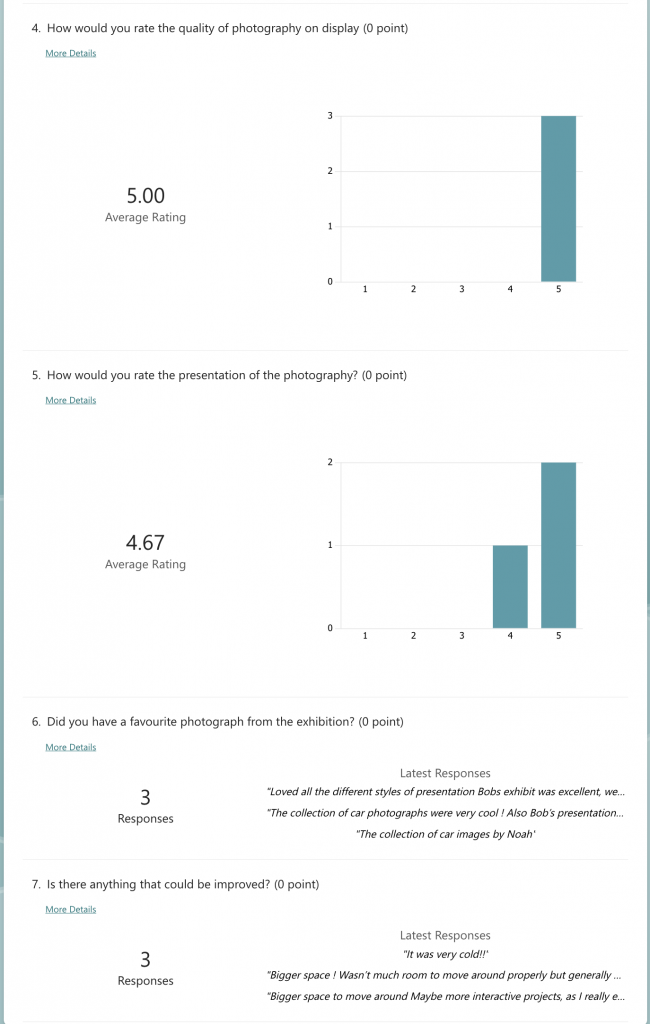
The free text responses are summarised in the above screen but can be sought out as the full text:


The paper book containing responses can be seen below, we had five responses in here but most were positive.
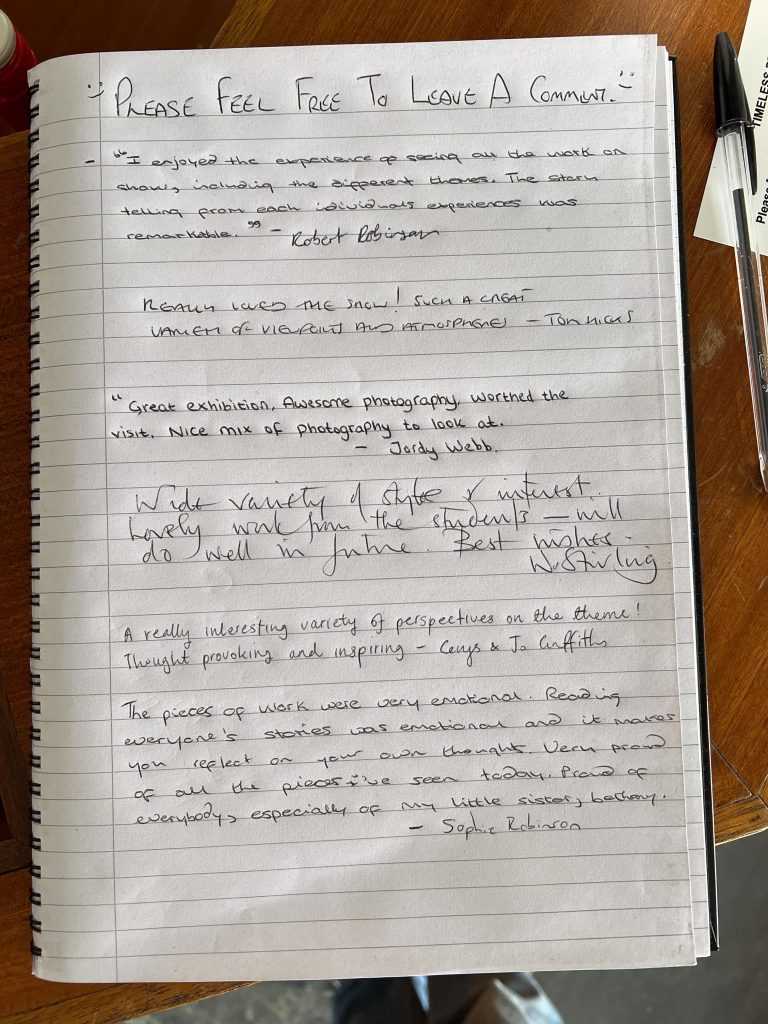
Reflection
As an exercise, the preparation of the exhibition and the implementation of everything was successful. All students learnt a lot about the process of putting an exhibition together and help from Sylvia was undoubtedly a reason behind the success. Her knowledge and expertise from her curator role provided some invaluable lessons and informed us of traps we may have fallen into.
There were a few upsets in the team through some misunderstandings but talking things through seemed to resolve most of the issues. I knew nothing about the problems whilst they were happening but it shows that projects need everyone pulling in the same direction and having the ability to work collaboratively with everyone in the team.
We collaborated well using Instagram chats, canvas, whatsapp, sms messages and email to ensure that we were all aware of the issues pressing and sharing information such as statements and ideas on refreshments etc.
The feedback we had, although limited, was generally positive but there were a couple of comments about the size of the space. We as a team thought that the space was about right for the number of photographers who were presenting work. A larger space would have felt empty and required more works to fill any space. The artists at the Eagle Works told us that it was good to see how we had creatively used the space available to us, including the unusual mounting of my work to the hanging of backlit transparency paper on the windows by Emma.
I also spent time talking to the other artists who are resident in the studios and all were positive about having us in the project space, one of them even offered to buy my work from me once the show was over. Unfortunately it is entered into the Shrewsbury Arts Trail so isn’t currently for sale.
The work I chose to show was well received in general, with a few confused looks on some peoples faces as to where and what I was photographing. Looking at the artist statement confirmed what they may have been seeing so I didn’t get many further questions about the work, over and above those mentioned in previous posts.
Sylvia also commented on my work saying that she liked it but felt that it could have been in larger scale so that people would be almost faced with bein gin the factory. As if standing in front of the expansive image might almost make you feel like you were in the image and experiencing it.
Rob Elkington from Arts Connect also followed up with an email to Sylvia with some lovely words in it for all of us students. One particular line that was very kind was as follows:
I found the exhibition very impressive in the thought and purpose of each exhibit, the connections to theory, the quality of production and the courage to get work out there in public.
Rob Elkington, 2024
The lack of visitors on the Friday and Saturday was expected as I don’t overestimate the draw we would have but others were disappointed that there were fewer than they expected. For me I took every opportunity to talk to other artists and engage with them about their practice, finding out more about their work, their methods and possibly even networking a little, which I find very difficult to do but know that it is necessary.
Many people took one of my zines too, each are numbered from 1 to 100 and I think about 35 went during the course of the exhibition. I had some nice comments on these also, as it helps contextualise the photos on display with others that show the viewer more of the factory.
What would I do differently?
The previous posts on the exhibition have explained a bit about the show, and how it went but what might I change about my exhibition work if I had to redo it?
First thing I might think about is the presentation of the images on the acrylic, if I had more room I would have used the three pallet idea mentioned in this post. I wanted to do this as it would have meant larger print sizes and a three dimensional exhibit that might help the viewer to spend time walking aroudn the three sides and examining each of the images, with them also being larger, they might have been able to look more closely into the detail on each.
This work on pallets aligns to work I’ve seen in the past at exhibitions such as Ingrid Pollard’s Bow Down and Very Low -123 2021 which were a few kinetic sculptures made of industrial materials.

Even as far back as 2014 in Shrewsbury Flaxmill Maltings I’ve seen work as per the image below, where the materials relevant to the location and the contents were used to help contextualise the art on show.

Even some work in the Beyond The Streets exhibition in the Saatchi Gallery in April 2023 had some localisation materials to contextualise the art in place. It was an exhibition about street art, graffitti and the culture and community surrounding street art. I hadn’t noticed too much at the time that this one wall filled with the work of Graffitti artist 10FOOT had the contents similar to that of beside an underground train line.

You can see at the base of the wall, a load of cables, pipes, tubes and wires that almost have you standing on the side of the track looking at the art on display.
This sort of material in the field of display helps me to get across the feel and atmosphere of the location being shown in the images on display.
For me this brings together the work that I’ve been investigating this year. I’ve started off with isolated scenes with nobody in them, then moved onto liminal spaces and then finally scenes of a place normally occupied by people in the daylight hours. The industrial look and feel of each of the images in the Shutdown series does help the viewer to gather the general type of environment that they are examining.
Different materials? Maybe, the acrylic was very reflective and I wondered if a matt finish might suit better. I had done test prints on matt paper but the light seemed muted in the photograph where in the acrylic it shone through and seemed to pop. The warm tone in the centre image and the left and right images showing a colder light almost bracketing the centre photo.
If I’d gone with three or a different number of prints going straight onto the wall, I think I’d have looked at the similar method that Shellie used, on heavy fine art paper mounted on board with a floating mount, as if to appear to be floating off the wall. These prints were matt and the colour and tone were something to behold, I only thought about this after I’d noticed on the third day of seeing her work, when I spotted the red highlight positively glowing off the thigh of the subject’s leg in the centre of the three photos. The red section seems to glare out of the photograph at me and I note that if I’d used this process/material for my prints that the light flares might have popped like this also. Her images were also a good size, I think A1 and it helped to be seen from all around the room.

The zine idea was a good one for me and it helped with getting people to engage with the work and if they didn’t ask the questions, then some of them might have an answer from the last page containing the text, The lights behind the pallet were also well received for the effect of providing some local context as though the light from the image was leaking out onto the wall behind. It was very subtle in the daylight and I think this was a positive, if it had been too bright or darker times then I think it may have detracted from the impact of the images.
Overall I was happy that in the end, although being restricted by gallery space, I was able to utilise a cut down version of the pallet and poles idea as it helped my work stand out and stand away from the wall. It was also mentioned by some visitors that the engineering element came across from the use of the pallet and metal poles, which is precisely what I was after.

Thanks
We must thanks all those who got involved to help us, from Sylvia who helped us get it together, to the artists and organisers at Eagle Works who supported us throughout by being on site to open up and lock up afterwards. Technicians, lecturers, and everyone else who helped each of us with our preparation are greatly appreciated. I bought a card for the Eagle Works team and Sylvia to express our thanks, it’s something small and simple but as they say, it’s the thought that counts.
Be First to Comment